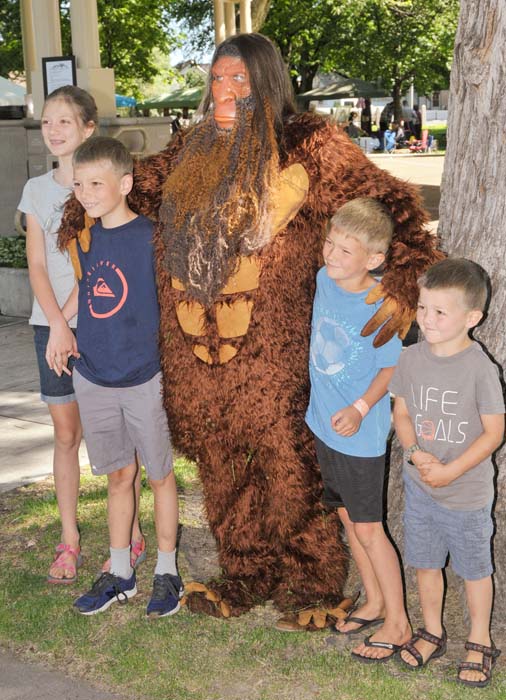Sasquatch Smiles
Published 2:20 pm Wednesday, July 17, 2019

- A costumed Bigfoot was a popular attraction at the inaugural Blue Mountain Bigfoot Festival in July 2019 at Geiser-Pollman Park. Among the many visitors who posed for a photograph with the hirsute beast were, from left, Ilania, Micah, Silas and Isaac Dickison.
Jeff Meldrum, with his neatly trimmed gray beard, mellifluous voice and smooth cadence, seems to be the archetypal college professor except that he’s holding what appears to be the footprint of a giant.
Meldrum is in fact a professor.
But as he stands in the shade of a canopy on a flawless June morning at Geiser-Pollman Park, brandishing this peculiar piece of plaster, it’s obvious that his specialty is not, say, English literature or economics.
Meldrum, 61, is a full professor of anatomy and anthropology at Idaho State University in Pocatello. He’s taught there for 26 years.
But it’s not his reputation for lecturing on human anatomy that brought Meldrum to Baker City on Saturday.
It’s Bigfoot.
Sasquatch, the other common name for this massive, hirsute creature that some believe inhabits the wild woods, as yet unrecognized by science, is the theme for the inaugural Blue Mountain Bigfoot Fest that drew an estimated 1,000 people to the park for the day-long event.
Scot Violette, a Baker City drama teacher and the founder of Blue Mountain Bigfoot Research, coordinated the event that included a 5K run, a variety of vendors in the park hawking Squatch-related merchandise, and a presentation by Meldrum.
The professor was certainly one of the star attractions of the day-long festival.
Meldrum has for more than a decade been the most visible accredited scientist endorsing the probability that Sasquatch is a real animal, lacking only formal taxonomic recognition.
He has appeared in many documentaries, been interviewed for dozens of newspaper and magazine stories and is himself the author of “Sasquatch: Legend Meets Science.”
A steady stream of people lingered at Meldrum’s display of purported Sasquatch footprint casts. Hanging from the rear of the canopy was a poster-size print of a frame from the most famous film ever made of a possible Bigfoot — the Patterson-Gimlin film made on Oct. 20, 1967, along Bluff Creek in Northern California.
Some people asked Meldrum to sign a copy of his book.
A few wanted to take a photograph with him.
Most seemed to recognize the man who shows up in many cable network shows featuring Bigfoot.
Yet despite his reputation as, in effect, “Professor Sasquatch,” most of Meldrum’s work involves teaching students about more prosaic topics such as why human feet look the way they do, and why we walk the way we do.
Indeed it’s Meldrum’s particular interest in how humans came to walk on two feet — as Sasquatch is supposed to do, according to hundreds of eyewitness reports and based on thousands of footprints found — that helped lead him to examine the possibility that the nearest genetic cousin to homo sapiens might remain undocumented by science.
He said the proliferation of TV specials and other media over the past two decades or so has thrust him into the very public role he maintains.
“It has certainly grown over time as interest in the subject has grown in both professional circles and the public eye,” Meldrum said.
He has been invited to speak at libraries, museums and universities across the country and abroad.
Meldrum concedes that a common complaint among Bigfoot enthusiasts, the vast majority of whom are not trained scientists, is that the scientific community doesn’t simply ignore the topic but condemns it as farcical — little removed from a belief in dragons or fairies.
That viewpoint isn’t wholly without merit, Meldrum said, but it’s not altogether fair, either.
He said an increasing number of younger scientists are showing an interest in the idea that Sasquatch or other “relic hominoids” might be roaming wild country.
(The “relic” refers to the idea that Bigfoot might be a confirmed animal from the fossil record that has survived to the present. A frequently cited candidate is Gigantopithecus, an ape known from teeth and jaw bones found mainly in China.)
“I’m interacting with my colleagues behind the scenes on this topic,” Meldrum said. “The possibility that the creature does exist is very real. There are many younger academics, not constrained by what I call the old guard and the idea that because Sasquatch can’t exist that therefore it doesn’t exist, who are willing to look at the evidence more objectively.”
He concedes that not many of these researchers are willing to discuss their interests publicly, for fear that they will hamstring their career potential in academia.
Meldrum said he counsels his younger colleagues to be careful expressing contrarian views until they have the security of tenure, as he has.
In the meantime, Meldrum continues to be, if not the lone scientific voice supporting the strong possibility that relic hominoids walk the Earth, then the most often cited voice.
“Often times I am along in sharing my insights and my opinions,” he said.
For the past decade or so, Sasquatch aficionados have touted DNA testing as the best way to prove the animal’s existence, an optimism based largely on the notion that a scientifically accepted tool such as genetic testing will be vastly more persuasive to skeptical academics than comparatively crude evidence such as footprint casts and the invariably fuzzy photographs and videos.
So far, however, DNA has not yielded the confirmation proponents have hoped.
But Meldrum believes DNA remains a potentially decisive technology in the campaign to prove Sasquatch is real.
The challenge, he said, is obtaining samples and, more so, properly testing them.
Although the public, accustomed to miraculous work on TV shows such as “CSI” and to ads from companies that need only a saliva-soaked swab to tell you what percentage of your ancestry is from, say, Eastern Europe, might believe DNA sequencing is simple, the reality is quite different, Meldrum said.
The sort of basic testing that a person buys for a hundred bucks or so on the Internet is far less sophisticated than what would be needed to conclusively prove that a sample from a purported Sasquatch is indeed from a species not yet identified, he said.
Meldrum said he is trying to raise money to undertake a study of what’s known as “environmental DNA.” The idea is to collect not just shafts of potential Bigfoot hair or bits of scat, but rather samples of soil, water and even air in places where the creatures are thought to frequent.
The resulting tests are exhaustive and expensive, but they have the potential to yield interesting results, Meldrum believes.
Yet for all the attention DNA has received recently, Meldrum contends the more traditional evidence that Bigfoot proponents cite — including those namesake footprint tracks — remain “absolutely compelling” items.
Meldrum concedes that some prints are the work of hoaxers.
Others are likely misidentified prints left by a known animal — bears, for instance, when their front and back paws overlap, can leave tracks that look similar to putative Sasquatch spoor.
Yet Meldrum believes the sheer volume of the footprint casts and reports — and the reality that if only one is genuine then so is the animal — justifies serious consideration of the viability of Bigfoot as a real species.
“Something has to create these footprints, and something is seen by eyewitnesses,” he said.
Meldrum’s visit to Baker City is far from his first trip to Northeastern Oregon.
He has done research in the northern Blue Mountains in the Tollgate and Walla Walla watershed areas, where many people have reported seeing Bigfoot or finding its tracks over several decades.
See more in the June 17, 2019, issue of the Baker City Herald.




